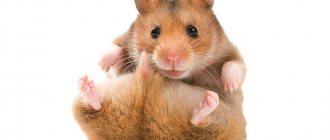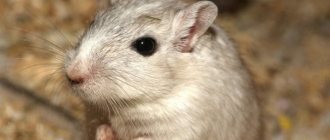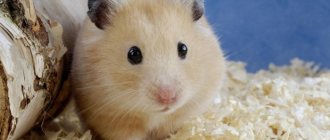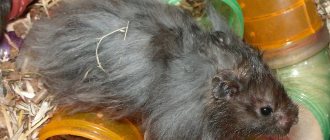It happens that the owner of a hamster notices that his pet falls on his back, rolls over or somersaults. Often this behavior puzzles a person. And there may be several reasons for it.
When does a hamster fall on its back?
Fight with another hamster
Swimming on land
How to prevent a fight
Tips and tricks
Video "Falling Hamster"
When does a hamster fall on its back?
A fall should be understood as a sharp or slow rolling from the paws to the back. In this case, the animal may squeak or, conversely, make louder sounds. The accompanying symptoms will tell you what the main reason for this behavior is.
Fight with another hamster
It is known that these rodents love solitude and do not accept proximity to other animals, even of the opposite sex. The mating period between males and females lasts no more than an hour, after which two adults can fight even to the death. In this fight, the male often dies, since the female is by nature more aggressive and always considers herself the mistress of the cage.
Sorry, there are no surveys available at this time.
Many rodent owners are interested in the question of why hamsters fight and whether it is possible to make two males or two females coexist peacefully in the same cage. The answer is simple: no matter how many animals you have, each of them should have its own home, and nothing else. If you do put your pets in the same cage and notice that your hamsters are fighting, then move them out as soon as possible.
Disease
Another reason why a fluffy puppy falls on its back and rolls over may be the pet’s painful condition. If at the same time he squeaks, screams, or, conversely, looks lethargic and inactive, then you should quickly take your pet to the veterinarian to find out the reasons for this behavior. In the meantime, first examine the rodent: sometimes the symptoms of the disease are visible to the naked eye.
Swimming on land
Another reason why a pet can roll over on its back is a banal instinct. The fact is that in the wild, rodents bathe in sand in order to somehow fight parasites. These instincts are retained during their life in a cage. You don’t need to do anything about it, just monitor your pet’s behavior and health.
When a fluffy is bathed to clean its fur, it rolls on its back and twitches its paws, and then jumps up sharply.
Why do caged hamsters often do backflips?
I can assume that it is precisely because he is in a cage (limited space) that he reaches the end of the cage, rests against the bars and, in order to avoid turning around again, does a somersault... he is bored in your cage, you need to put some kind of swing, the wheel is spinning, in general, keep the guy busy...
You can definitely feed. Not even because they are all rodents or anything else.
Hamsters, guinea pigs, mice, rats and hedgehogs will happily feed on them. But I don’t think this will be their regular diet? It would be nice for a hamster and a guinea pig to add some grass (hay, straw).
For rats, mice and hedgehogs, this will be a real delicacy. (I remember when I was a child we fed a hedgehog at home, an excellent catcher of crickets and cockroaches)
By the way, mealworms are a delicacy for them, and they rarely refuse animal food.
Of course, there are doubts about the difference between wild animals and animals from nurseries, but still they are animals and instinct will take its toll.
The most you can put on a hamster is a raincoat. But if you love your pet, then you shouldn’t do this, for people it’s a joke and a holiday, but for the animal it’s real torture. The cloak will get in the way and hinder his movements, no matter how well it is made, the hamster will feel discomfort and try to remove it.
Therefore, do not spoil the New Year for your hamster, but rather, arrange a holiday for him and treat him with something tasty)
Judging by Yandex pictures, Putin generally loves animals, which is usually (according to psychologists) a sign of some dislike for people. Leopards, dogs, horses, dolphins, tigers - these are perhaps the main types of animals in whose company he can often be seen. And for some reason he also likes to bottle feed calves.
No hamsters were seen in his environment. He probably just doesn’t notice them when he walks, and then there’s nothing to notice.
You can prepare different foods for hamsters.
People give hamsters not only dry food, but also prepare various tasty treats.
My friend loves hamsters and very often cooks different dishes for them.
Recipe No. 1 . Dry food, boiled chicken egg, spinach leaves. The egg is crushed, the spinach is also cut into small pieces, dry food is added, everything is mixed and given to the hamsters.
Related Issues
What to do if your pet not only falls, but also looks weak, makes drawn-out sounds and rolls his eyes? Most likely, this behavior is an alarming signal to contact a specialist.
In this video, the rodent funny turns over on its back.
Squeak or scream
Most often, a fluffy squeaks because it is experiencing pain or discomfort. This sound is difficult to confuse with another, since in case of danger or the presence of another rodent, the pet will make a completely different sound. What to do when you squeak? Examine your pet and observe its behavior.
Sand bath - heaven for a hamster
If you decide to bathe your hamster in water, then you need to do this with extreme caution. Hamsters do not naturally bathe in water. The only suitable bath for a rodent can only be made of fine sand. It is while taking such a bath that you may notice that the hamster tumbles onto its back and back. This is explained by the fact that it is so inherent in nature, and the animal’s natural instinct is triggered. Sometimes it happens that a hamster can perform somersaults just like that, without sand, in this case you can prepare a sand bath for the baby. But nothing bad is happening to your pet at this moment, so you can observe his unusual actions.
We described in detail how to properly bathe a hamster in this article.
Video "Falling Hamster"
In this video, a rodent comically climbs and falls on its back.
Support the project - share the link, thank you!
Sometimes owners may see an unusual picture: the hamster falls on its back, somersaults over its head, and a second later finds itself on all fours and continues its usual activities. Of course, this behavior alarms caring and attentive owners, as it may indicate the development of a disease.
To understand whether it is worth contacting a veterinarian in this case, you need to understand the physiological and pathological causes of the condition in which hamsters fall on their back.
- Why does a hamster fall on its back?
- Pet needs a sand bath
- Defensive stance
- Falling from height
- The pet is sick
Defensive stance
One of the reasons for a rodent falling on its back may be a defensive reaction. If a hamster begins to defend its territory from another rodent, it will often take a defensive stance. It allows the little hamster to appear more menacing and strong.
What exactly characterizes the stand:
- Falling on your back.
- Staying in one position for a certain period of time.
- Flatten ears.
- Raised paws up.
With these actions, your pet defends its right to territory and will fight for it to the end. You should not touch him in this state; there is a fairly high probability that the hamster may bite you. An animal in a fit of aggression may mistake you for an enemy, so be careful.
Why does a hamster fall on its back?
If your pet maintains mobility, appetite and cheerfulness, then there is no need to worry. However, if the hamster falls down as if paralyzed, pulls its hind legs, becomes lethargic and apathetic, then you should immediately contact a veterinary clinic.
There are physiological and pathological reasons for this behavior. To determine them, you need to carefully monitor the accompanying symptoms and the general condition of the hamster.
Pet needs a sand bath
In the wild, hamsters use sand baths to combat parasites. The rodents fall on their backs, somersault, quickly jump up, and then repeat everything again.
Pets do the same on an instinctive level. Therefore, if the hamster begins to tumble backwards, then it is worth offering him a bath of fine, purified sand.
Defensive stance
The reason a hamster falls on its back may be a defensive reaction. No matter how strange it may seem, the defensive stance of a rodent is characterized by:
- falling on your back;
- freezing in this position for several seconds;
- pressing ears tightly;
- raising all four paws up.
This pose shows that the animal is belligerent. Therefore, you should not disturb him - at this moment he may bite or scratch severely.
Falling from height
A hamster's hind legs may fail due to injury from a fall from a height onto its back. In this case, severe bruises, dislocations, fractures of bones and the spinal column may occur, hematomas may form, compressing muscles and nerve endings.
Note! After a fall, the hamster can lie on its back for a short time, as if sleeping. This behavior is a reaction to stress. If the rodent soon turns over and returns to normal activities, then there is no need to worry.
If the hamster's hind legs fail, you should try to limit the pet's mobility and inform the veterinarian about damage to the leg or spine. Subsequently, it is necessary to remove all ladders and crossbars from the cage, replace the bedding with soft paper napkins, and additionally introduce foods rich in calcium into the diet.
The pet is sick
A condition in which a hamster's hind legs suddenly fail may indicate a stroke or heart attack. These pathologies can be triggered by severe stress, which is caused by:
- loud sounds;
- sudden switching on of very bright light;
- the appearance of unfamiliar animals in the room;
- moving to a new place of residence;
- lack of attention from the owner or, conversely, his excessive intrusiveness.
Important! Severe fright can lead a hamster to sudden death.
Paralysis of the limbs, in which the hamster's hind legs give out and it falls on its back, can be the result of age-related changes. In most cases, this symptom indicates the approach of death.
Diseases that can cause hind leg failure in hamsters include:
- malignant tumors;
- inflammatory processes in internal organs;
- hernias;
- infections affecting nerve tissue.
In this case, the following symptoms also indicate the development of hamster pathologies:
- apathy;
- lack of interest in food;
- disheveled and unkempt fur;
- dirty genitals and tail.
If your hamster has any of the listed signs, you should immediately show your pet to a veterinarian. After all, pathological processes in rodents develop rapidly, and any delay can cost the animal its life.
We always have a lot of different animals in our house. Usually they bring a lot of positive emotions, but, unfortunately, they can also cause a lot of trouble during illness. Due to the somewhat excessive emotionality of the wife and daughter :-), we have to make every effort (and sometimes very immodest money) to combat the sores.
We purchased a 4-month-old Campbell hamster from a regular pet store. Everything was fine for a month. Senechka adapted, got used to the hands, food, shelter and wheel. Although a hamster is quite simple to keep, I still think it is necessary to study articles and thematic forums in detail in order to understand how to arrange a home and properly feed a new pet. Apparently, this time there was a problem with the nutrition.
In general, everything was fine for a month. But one day he had an attack. The hamster suddenly screamed, began to rush around the cage and after a minute began to convulse. I pulled him out of the cage without having the slightest idea what was going on. The only thing that came to mind was choking? He massaged his neck, chest, checked his cheeks. There is nothing. The hamster lay in the palm of his hand, barely breathing, all crooked. I start googling as quickly as possible, I understand that this is epilepsy, I look for what to do, and I find on several sites one single article: the cause is unknown. What to do - give a couple of drops of strong alcohol. This will relieve the attack, but the hamster does not have long to live - attacks will occur more and more often, and if not in a day, then in a week, he will go to the rainbow (or is it only birds who go there?). Actually, this was the end of the information about epilepsy in hamsters.
They dripped vodka into the lid and dunked Senya's face twice. And in a matter of seconds the cramps passed. He slept peacefully for the next hour, drunk, as I understand it. Over the next 3 days he had up to a dozen such attacks. And more and more often. Actually, as predicted. They were going to take him to the clinic and put him to sleep. But previous visits to clinics with our other pets ended with checks that could buy two or three dozen hamsters. Of course, I feel very sorry for the animal, but you also need to maintain some kind of rationality. In general, they refused. Here there is unconfirmed information that vitamin B6 can help. Full of pessimism, I bought an ampoule of the vitamin (issue price: 2 UAH).
And then the problem of dosage arose. Damn it, the daily requirement of vitamin B6 for a hamster is not written anywhere! Moreover, there are no ones for cats and dogs either! I had to go beyond human norms. Having accepted that an adult needs 2 mg of vitamin per day, the weight of a hamster is 20 g, and the solution is 20%, I, using simple calculations, found Senechka’s daily dose of vitamin B6 - 0.0005 mg. 5 ten-thousandths of a milligram, Karl! How to measure this? Very simple: a couple of drops for a full bath. Drink the resulting solution. But, of course, I didn’t do this, because I further read that vitamin deficiency is very rare. because the excess is easily metabolized. Therefore, the first two doses were truly horse-dose for the hamster - a drop on the cap of water. After all, there was nothing to lose. Next - a drop in a 40 ml drinking bowl for a week. And a miracle happened: after the first dose, and for three weeks the attack did not recur. Senya fully recovered and returned to his former life.
At first I said that the problem was probably in the stern. We fed him grains from a parrot diet. Apparently they do not contain the correct vitamin composition for hamsters. In addition, fresh vegetables, which are recommended for a healthy hamster, were completely excluded from the diet. I’ll say right away that we never gave him anything from the table - we’ve already been burned with this by the example of other animals. The pet should eat only the diet assigned to it, without a single exception.
Please note that I am not a veterinarian and there is no direct evidence that it was vitamin B6 that saved the hamster from epilepsy. But it looks a lot like it. However, the point of this article is to possibly help the animal in conditions of a complete vacuum of information on this topic.
Hamsters have become quite popular pets these days. They are inexpensive to purchase, easy to acquire and easy to maintain. However, these animals, like others, can also get sick and experience stress. Why does this happen and how to avoid it?
Why is the hamster nervous? This is influenced by various factors: environment, pet care, feeding, genes, breed and even the character of the hamster itself. Therefore, it is important that the owner knows the usual behavior of his pet. This way he can understand if something strange is happening to the pet.
Absolutely all hamsters become anxious:
- Sudden, sharp movements nearby;
- Loud unexpected sounds.
You should be careful when picking up your hamster. Pets who are not accustomed to such a gesture recognize it as a capture by a bird of prey. Naturally, this will cause them stress.
Poorly socialized hamsters have a hard time living together with other animals, as well as noise around them. This is because, out of habit, they perceive these factors as threatening their lives.
Here are the reasons that can cause stress even in socialized hamsters:
- A cramped and dirty cage;
- Poor, unbalanced diet, lack of water;
- Lack of items for mental and physical activity;
- Diseases and injuries.
Hamsters are very clean animals, so living around excrement invariably causes stress for them. It’s the same with nutrition: the lack of certain nutrients and microelements in the body does not have the best effect on their health.
How can you tell if your hamster is stressed?
- Hyperactivity. As a rule, hamsters behave very animatedly when stressed. They chew the bars, rush around the cage, run in the wheel. This is how they try to relieve tension.
- Obsessive behavior. The pet constantly repeats the same action - gnawing something, scratching, “chasing its tail,” washing itself. Sometimes the hamster begins to harm itself. This is doubly dangerous, because infection can get into the wound.
- Aggression. Stress is one of the main causes of aggression in hamsters. If a rodent shows its teeth, rolls its ears back and grunts, do not touch it.
- Baldness. Due to severe stress, animals lose hair in places or completely. If you see bald spots on a hamster’s skin, this is a reason to change something in his life.
- Sounds. Hamsters are usually very quiet animals, but when stressed they may snort, grunt or even squeal.
- Increased salivation. When there is fear, anxiety and nervousness, more saliva is produced.
- Tremor. With severe fear, the muscles tense, sometimes so much that the hamster begins to tremble.
- Attempts to escape. When stressed, a hamster will try to escape from an unsafe environment. He will always be ready, with his ears facing forward and his cheeks puffed out.
- Change in behavior. He just becomes different, not the way you remember him. It is important to know what behavior is normal for a pet.
How to relieve a hamster from stress? There are several recommendations on this topic. Firstly, with any sign indicating stress, you need to leave your pet alone and allow him to come to his senses. Sometimes it helps to put the cage in a quiet, dark place (but without drafts or cold).
If you suspect that your pet is injured or ill, you should contact a veterinarian. Nowadays, even such small animals as mice and hamsters undergo operations under anesthesia, tumors are removed and fractures are healed.
It is very important to provide your pet with everything necessary for a comfortable life - a spacious cage with a home and loopholes where he will not get bored. One wheel is not able to bring joy to a hamster and satisfy all the needs for physical and mental activity. Some even believe that it only harms. So take care of pipes and ladders. Moreover, it will be more interesting for you to watch your pet.
An aquarium or jar is not suitable for keeping animals. There is not enough ventilation, and the hamsters have to breathe harmful ammonia.
Hamsters need solid food, as well as wooden blocks to wear down their teeth, which are constantly growing.
Never sneak up on your hamster or pick him up abruptly. If you want to pick him up, do it carefully, from the side, so he can see you. Hand training also needs to be done gradually.
Do not buy a hamster for small children. They do not always see the difference between a toy and a living creature, and therefore can unwittingly strangle the pet.
Hamsters belong to the rodent family and are no less popular pets than cats or dogs. In order to keep hamsters at the proper level, you need to know all the nuances about their nature. In this article we will try to consider the most basic diseases of hamsters that an owner may encounter when keeping them.
Learning to do more difficult tricks
Only disciplined hamsters, previously trained in minimal skills, can learn to do more complex tricks. There are many difficult tricks for a hamster; below are the most spectacular of them, the training of which will be discussed in more detail.
Jumping through a hoop
Some hamsters are quite jumping and, if such a feature has been noticed in your pet, it can be trained to jump through a hoop. For rodents, you should choose a circle with a diameter of 7 cm so that they do not cling to the edges while jumping.
We suggest that you familiarize yourself with information about which is better to get - a rat, a hamster or a guinea pig.
Training begins by placing the hamster on a hard horizontal surface. A hoop is placed between the rodent and the treat, which is raised above the surface by a maximum of 1 cm. To get to the treat, the pet will have to jump, but you should not hope for a quick result - the most resourceful hamsters, seeing an obstacle in front of them, simply bypass it, so it’s better hold the hoop in your hand and follow the pet’s trajectory, forcing it to jump.
Overcoming obstacles
Performing a trick with obstacles that the hamster must overcome is based solely on the animal’s desire to enjoy the goodies with which it will be constantly lured. A purchased or home-made track with labyrinths, pipes and double-sided stairs is installed on a horizontal surface and, with the help of food, the rodent is stimulated to move along the track. At the end of the journey, the pet must be rewarded with a treat.
Diseases of hamsters - oral cavity and skin
Boils. Hamster diseases
Hamster abscesses are a type of abrasion that appears mainly on the pads of hamsters' feet.
- reasons - the exact cause of the appearance of abscesses has not been found, but veterinarians are inclined to mechanical injuries;
- symptoms - the presence of abrasions on the pet’s paws, which are detected during a visual examination of the hamster;
- treatment - most often, to eliminate abscesses in hamsters, doctors prescribe the use of ointments with zinc or fish oil, or preparations based on these components. Treatment of such a seemingly minor disease can take several months, since the pads are very sensitive and are constantly exposed to stress.
Anomalies of teeth. Hamster diseases
Anomalies of teeth in hamsters - all representatives of rodents have such a feature as the constant growth of their front teeth. Because of this, the animal’s bite may be disrupted and the teeth simply do not close. This already leads to digestive disorders, etc.
- reasons - the cause of such anomalies may be genetic characteristics that imply accelerated tooth growth, or the cause may be a diet that contains very little solid food. The animal simply does not have time to grind down its teeth;
- Diseases of hamsters often spread to the teeth; the most common symptoms of dental pathologies are increased salivation. The pet may refuse food, stop gnawing food;
- treatment - to cure this type of pathology, you should not self-medicate, but seek help from a veterinarian. Often a procedure such as treating teeth with a drill is performed. If “hooks” appear on the teeth as a result of the disease, they should also be removed.
Inflammation of the cheek pouches. Hamster diseases
- reasons - inflammation of the sacs occurs if there is any damage to them on the inside. Also, if food is constantly stored there, an inflammatory process may occur due to the interaction of tissues and fibers of the products;
- symptoms - as a rule, symptoms of inflammation of the cheek pouches may be absent at all. But there may also be a decrease in appetite due to painful sensations;
- treatment - it is possible to fix the inflammation only by contacting a veterinary center, since to examine the cheeks from the inside you need to turn them out correctly. If you do not have the necessary skills, you can cause discomfort to your pet. Inflammation is treated by removing remaining food and treating with bactericidal agents.
Hair loss in hamsters
Baldness in hamsters may be confused by some owners with lichen, since they are very similar upon visual inspection. The only difference that can clarify the picture is the presence of scales in areas of hair loss with lichen, while with baldness the skin remains smooth. You should not diagnose yourself; in any case, you should consult a veterinarian.
- reasons - the causes of baldness in hamsters include the following factors: a decrease in the intake of vitamins and minerals in the body, frequent and severe stress in the pet;
- symptoms - symptoms manifest themselves in hair loss, you can also notice apathy and lethargy in your pet;
- treatment - if there is a lack of vitamins, they should be included in the hamster’s diet. If there is stress, it is necessary to exclude its occurrence.
Herpes in hamsters
Herpes in hamsters is an inflammation of the skin near the mucous tissues of the animal.
- reasons - a hamster can become infected with herpes through contact with other hamsters;
- symptoms - the disease occurs without any visible symptoms. It can be detected more often only during routine veterinary examinations;
- treatment - this disease does not require special treatment and goes away on its own in one to two weeks, but in any case, consultation with a specialist is necessary to know exactly what ailment your pet has.
Trichomonosis. Hamster diseases.
Trichomoniasis in hamsters is a disease caused by the activity of a parasite from the Trichomonas gallinae family.
- reasons - the parasite can enter your hamster’s body by drinking dirty water or bad food. Due to weak immunity, young people are especially more susceptible to trichomoniasis than adults;
- symptoms - manifested in a yellowish tint of the pharynx. Subsequently, it increases in size, as if it swells and blocks access to oxygen;
- treatment - carried out through the use of medications that should only be prescribed by a veterinarian. If you do not help your hamster in time, death is possible.
Conjunctivitis in hamsters
Conjunctivitis is also a disease of hamsters; it is a pathology associated with disruption of the mucous membrane of the eyes.
- causes - bacterial infections or colds that cause complications;
- symptoms - there may be copious discharge of mucus from the eyes;
- treatment - doctors recommend rinsing the eye mucosa with salt water or using special drops.
Digestive diseases in hamsters
Obesity in hamsters
Obesity in a hamster - an increase in the amount of subcutaneous fat in a hamster can have a bad effect on other organs, such as the heart. By nature, the hamster is a mobile animal and needs constant exercise.
- reasons - a decrease in physical activity, often due to the fault of the owner, when living conditions do not meet the requirements;
- symptoms - a visual increase in the fat layer in the hamster. Decreased overall activity
- treatment - increasing the load, installing various treadmills and attractions in the cage. Monitoring caloric intake.
Colibacillosis. Hamster diseases
Colibacillosis in a hamster is a disease of the gastrointestinal tract, which manifests itself in its disorder. Also, this disease is called “wet tail”. It has a bacterial origin. This intestinal pathology can mislead owners, since in the early stages it is similar to other diseases that are not of a bacterial nature.
- reasons - the presence of unfavorable bacteria in the body, which come from food or water;
- symptoms - the main sign is the presence of diarrhea in a hamster. Subsequently, lack of appetite, water diarrhea, aggressive conditions, bleeding are connected;
- treatment - colibacillosis can be cured only by following all the instructions and recommendations of a veterinarian. Most often, solutions containing electrolytes are used to improve the hydration process. Along with this, antibiotics are prescribed that stabilize the condition of the intestines. It is also necessary to adhere to a certain diet, which involves excluding certain foods from the diet.
Important! Colibacillosis can be transmitted to other individuals. Therefore, if you have other hamsters, they must be isolated from the infected pet.
E. coli is also a disease of hamsters
E. coli in hamsters is a disease that causes significant discomfort to the pet, even death. It is infectious in nature. As the disease progresses, the intestinal flora of the infected hamster changes due to the activity of the microbe.
- reasons - penetration of an animal microbe into the body;
- symptoms - signs of E. coli are a high body temperature in the animal and the presence of bloody diarrhea during bowel movements;
- treatment - the disease in most cases ends in death for the pet. It is very important to fix it in the early stages (which is very difficult, since it develops very quickly), in order to leave at least some chance of recovery.
Enteritis in a hamster
Enteritis in hamsters affects the organs responsible for normal digestion of the animal.
- reasons - doctors call the main factor in the development of enteritis, the lack of hay in the diet;
- symptoms: bloating and diarrhea;
- treatment looks specific. The feces of a healthy animal are taken, mixed in water and administered as an enema to the patient. It is also recommended to include hay in the diet to improve digestion.
Poisoning - diseases of hamsters
- reasons: poor quality of food consumed, presence of household chemicals on food products. Dirty or stagnant water;
- symptoms: loss of appetite, lethargy. Sometimes diarrhea and vomiting;
- treatment - a veterinarian should prescribe treatment based on the results of the examinations. It is important to distinguish poisoning from a viral infection. Failure to seek help in a timely manner can result in death.
Basic rules for training a hamster
Physical condition of the animal
You should not start training if your pet has health problems that cause him discomfort. Also, do not disturb the rodent during estrus, mating, or pregnancy. During such periods, hamsters will not be able to exercise to their full potential, and any training will end in failure.
Times of Day
The most suitable time for training is evening. Closer to night, hamsters are at the peak of their activity; they are more resistant to perceiving new information and working through exercises. As soon as your pet gets out of its house after a nap, you can safely start working with it.
Satiety
Train your pet on a moderately full stomach; when hungry, the pet will be distracted by extraneous odors, and the training will fail. Your hands should also be clean and free of food odor.
Confidence
Before a long training process, you need to build a trusting relationship with the rodent, you need to educate it and accustom it to your presence. A strong bond can be established through hand feeding. This way the pet will understand who its owner is and will get used to your smell.
Age
Training a hamster should begin at the right age - from 2 weeks from birth to 2.5 months of conscious life. This period is the most optimal period for training a hamster; at this time, he best perceives information and shows curiosity about the outside world.
IMPORTANT: If you start training too late, the exercises will not bear significant fruit, since the pet will not want to change its usual lazy lifestyle.
Diseases of the genitourinary system in hamsters
Cystitis in a hamster
Cystitis in a hamster is a disease that affects the genitourinary system
- Causes - The causes of cystitis can be both mechanical damage and nutritional disorders. It is also possible that the disease may appear due to the lack of the proper amount of water in the diet;
- symptoms include frequent urination and increased anxiety;
- treatment is carried out by using drugs such as buscopan. If after a course of taking medications the condition does not improve, it is necessary to re-diagnose using x-rays.
Hamster diseases - diseases of the nervous system
Lymphocytic choriomeningitis in hamsters
Lymphocytic choriomeningitis in hamsters is a very serious disease that is infectious in nature. Affects all organs.
- reasons - an animal can become infected through contact with a sick individual. The main carriers of this disease are mice;
- symptoms - appear almost immediately and are expressed in general weakness, difficulty breathing, body temperature increases;
- treatment is a disease, unfortunately incurable. If your pet has become a victim of lymphocytic choriomeningitis, measures should be taken to euthanize the hamster. This is the only way to put him out of his misery.
Important! All hygiene rules must be followed; this disease can be transmitted to humans.
Aujeszky's disease - what is important to know about this disease of hamsters
Aujeszky's disease - this disease is often called “false rabies”, since they have similar symptoms.
- reasons - the causative agent of this disease is a virus that affects the entire nervous system of the hamster;
- symptoms - signs of the disease do not appear immediately, but only after two to three weeks after infection. The disease manifests itself in increased excitability of the animal and the presence of itching;
- treatment - it is possible to cure Aujeszky's disease only in the early stages, if the disease is advanced, the virus covers the hamster's vocal cords, provokes the development of laryngeal paralysis, as a result of which the animal dies.
The purpose of cheek pouches in rodents
Wild hamsters need them to survive. The animals feed on small grains that are difficult to transport into burrows. Thanks to its huge cheeks, the rodent can make reserves. He fills the free space with food and carries it into the hole. The cheek pouches contain enough food to last the animal for a day.
Thanks to the habit of stuffing grains into its mouth, a pet can survive if it finds itself in a difficult situation. For example, when escaping from a predator, if the lair is far away.
Thanks to the supplies in the pantry, the animal easily endures hibernation. In winter, all life processes of a hamster slow down. He is in a daze and wakes up once a week to eat and relieve himself. This allows the pet to survive the cold season for which it is not adapted.
Other diseases of hamsters
Tumor in a hamster
A tumor in a hamster is a disease caused by the appearance of a neoplasm in the body in the form of a malignant tumor.
- The reasons are genetic predisposition. Some foods may have a positive effect on the development of cancer in hamsters. Older individuals also have a tendency;
- symptoms - signs depend on the location of the tumor, they can be different organs, and symptoms are vomiting, diarrhea, impaired movement, interruptions in the functioning of the body in general, etc.;
- treatment - involves the removal of a malignant neoplasm, but only if necessary.
Hamster heart disease
A hamster has heart disease - characterized by interruptions in the functioning of this organ. They are quite rare in hamsters.
- reasons - the presence of severe stress or high air temperature, which affects the regulation of the heart muscle;
- symptoms - shortness of breath, high pulse, apathy and decreased activity;
- treatment - in the first stages of treatment, it is recommended to change the conditions of the hamster’s keeping. If this does not help, and the condition only worsens, you need to administer an injection of Effortil. Again, all treatment is prescribed strictly individually. Self-medication should be excluded.
Colds are also a hamster disease
- reasons - may be hypothermia or the effect of a virus;
- symptoms - general weakness, sneezing, nasal discharge, discharge from the eyes;
- treatment - it is recommended to give pets fruits that are saturated with liquid to prevent dehydration. If colds are started, they can develop into more serious ones.
What animals are trainable?
Hamsters approach training differently: some readily learn commands and tricks, while others cannot be trained at all. And the point here is not laziness and harmfulness, but the natural characteristics of funny rodents, and also their age. In order for a hamster to obey you, you must first tame it, teach it to eat from your hand, and trust its owner.
The best age for training is between 3 and 10 weeks. It is at this time that the tiny animal learns about the world and tries something new. At a young age, hamsters develop skills that will stay with them throughout their lives. Kids are much more trusting and brave than adult animals. Therefore, training your hamster should begin as early as possible.
Animals older than 4 months are reluctant to train, and six-month-old hamsters completely ignore the owner’s attempts to train him. They will be drawn to treats, but they won’t follow commands without treats.
The physiological state of the fluffy is also of great importance in education. If Khoma is sick, he will have no time for entertainment. First you need to treat the animal, and only then start training.











